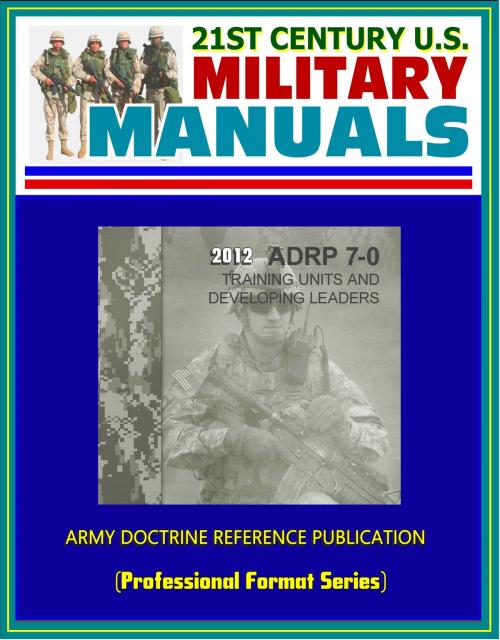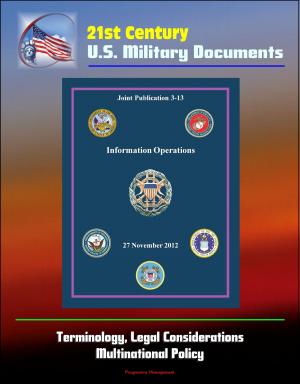21st Century U.S. Military Manuals: 2012 Training Units and Developing Leaders Army Doctrine Reference Publication (ADRP) 7-0 (Professional Format Series)
Nonfiction, History, Military, United States| Author: | Progressive Management | ISBN: | 9781301374205 |
| Publisher: | Progressive Management | Publication: | January 12, 2013 |
| Imprint: | Smashwords Edition | Language: | English |
| Author: | Progressive Management |
| ISBN: | 9781301374205 |
| Publisher: | Progressive Management |
| Publication: | January 12, 2013 |
| Imprint: | Smashwords Edition |
| Language: | English |
Professionally converted for accurate flowing-text e-book format reproduction, Army Doctrine Reference Publication (ADRP) 7-0, Training Units and Developing Leaders, augments fundamental principles discussed in Army Doctrine Publication (ADP) 7-0, Training Units and Developing Leaders. Both ADP 7-0 and ADRP 7-0 support the doctrine established in ADP 3-0 and ADRP 3-0. Army units will face a complex operational environment shaped by a wide range of threats, allies, and populations. Rapid advances in communications, weapons, transportation, information technologies, and space-based capabilities make it a challenge to just stay even with the pace of change. Because Army units face a wide mix of challenges—from strategic to tactical—they must develop leaders to conduct unified land operations anywhere in the world in any operation across the conflict continuum. Army training prepares units and leaders to be successful through challenging, realistic, and relevant unit training and leader development at home station, at the combat training centers, and in the schoolhouses.
The ADRP rescinds the idea that a separate and distinct training management process exists from the operations process for training and leader development. Such earlier concepts as long-range planning and short-range planning are now based on the military decisionmaking process and troop leading procedures as defined by ADRP 5-0 and Army Tactics, Techniques, and Procedures (ATTP) 5-0.1. Both ADP 7-0 and ADRP 7-0 support the idea that training a unit is not fundamentally different from preparing a unit for an operation. Learning the concepts, ideas, and terminology of the operations process as units train will make the transition from training to operations a more seamless effort for both leaders and their units.
Chapter 1 introduces the Army's concepts of training and leader development and the role of the commander in these. This chapter also specifies the role of the commander in training and leader development through the activities of understand, visualize, describe, direct, lead and assess. Chapter 2 re-establishes and re-affirms the principles of unit training and principles of leader development from the 2011 edition of FM 7-0. Chapter 3: Discusses the operations process in unit training and leader development. It introduces unit training management (UTM) concepts and discusses planning, preparing, executing, and assessing training.; Describes how UTM details the over-arching Army training management process.; Adopts the operations planning processes as the same processes used for planning unit training; Redefines the battalion- and company-level mission-essential task lists (METLs) as representing the tasks that support the unit's designed capabilities; Specifies mission-essential tasks at battalion and company levels; Replaces the unit long-range plan with the unit training plan; Rescinds the concept of short-range planning; Establishes operation orders, warning orders, and fragmentary orders as the formats used for communicating unit training plans and training events; Modifies the term after action review. Based on current doctrinal changes, the following terms for which ADRP 7-0 is proponent have been modified for purposes of this manual: after action review and mission-essential task. The term training domain is no longer formally defined but retained based on common English usage. The glossary contains acronyms and defined terms.
As a bonus, this reproduction includes the complete 2012 Army Leadership manual (FM 6-22), which describes the Army's view of leadership, outlines the levels of leadership (direct, organizational, and strategic), and describes the attributes and core leader competencies across all levels.
Professionally converted for accurate flowing-text e-book format reproduction, Army Doctrine Reference Publication (ADRP) 7-0, Training Units and Developing Leaders, augments fundamental principles discussed in Army Doctrine Publication (ADP) 7-0, Training Units and Developing Leaders. Both ADP 7-0 and ADRP 7-0 support the doctrine established in ADP 3-0 and ADRP 3-0. Army units will face a complex operational environment shaped by a wide range of threats, allies, and populations. Rapid advances in communications, weapons, transportation, information technologies, and space-based capabilities make it a challenge to just stay even with the pace of change. Because Army units face a wide mix of challenges—from strategic to tactical—they must develop leaders to conduct unified land operations anywhere in the world in any operation across the conflict continuum. Army training prepares units and leaders to be successful through challenging, realistic, and relevant unit training and leader development at home station, at the combat training centers, and in the schoolhouses.
The ADRP rescinds the idea that a separate and distinct training management process exists from the operations process for training and leader development. Such earlier concepts as long-range planning and short-range planning are now based on the military decisionmaking process and troop leading procedures as defined by ADRP 5-0 and Army Tactics, Techniques, and Procedures (ATTP) 5-0.1. Both ADP 7-0 and ADRP 7-0 support the idea that training a unit is not fundamentally different from preparing a unit for an operation. Learning the concepts, ideas, and terminology of the operations process as units train will make the transition from training to operations a more seamless effort for both leaders and their units.
Chapter 1 introduces the Army's concepts of training and leader development and the role of the commander in these. This chapter also specifies the role of the commander in training and leader development through the activities of understand, visualize, describe, direct, lead and assess. Chapter 2 re-establishes and re-affirms the principles of unit training and principles of leader development from the 2011 edition of FM 7-0. Chapter 3: Discusses the operations process in unit training and leader development. It introduces unit training management (UTM) concepts and discusses planning, preparing, executing, and assessing training.; Describes how UTM details the over-arching Army training management process.; Adopts the operations planning processes as the same processes used for planning unit training; Redefines the battalion- and company-level mission-essential task lists (METLs) as representing the tasks that support the unit's designed capabilities; Specifies mission-essential tasks at battalion and company levels; Replaces the unit long-range plan with the unit training plan; Rescinds the concept of short-range planning; Establishes operation orders, warning orders, and fragmentary orders as the formats used for communicating unit training plans and training events; Modifies the term after action review. Based on current doctrinal changes, the following terms for which ADRP 7-0 is proponent have been modified for purposes of this manual: after action review and mission-essential task. The term training domain is no longer formally defined but retained based on common English usage. The glossary contains acronyms and defined terms.
As a bonus, this reproduction includes the complete 2012 Army Leadership manual (FM 6-22), which describes the Army's view of leadership, outlines the levels of leadership (direct, organizational, and strategic), and describes the attributes and core leader competencies across all levels.















